-
-
-
-
-
-
-
-
-
-
Georgia
-
-
-
-
-
-
-
-
-
-
-
-
-
-
-
-
-
-
-
| Map of the Bartram Trail |
Arrival in Georgia
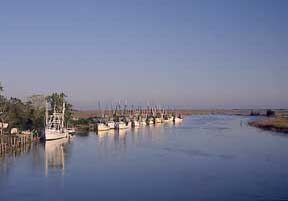 |
|
|
Shrimpboats at Darien |
Bartram’s arrival in Savannah (by schooner) in the spring of 1773 was auspiciously coincidental with the meeting of the colony’s assembly there. Bartram came to know several of the members who, in turn, invited Bartram “to call at their seats occasionally as I passed through the country.”(38)
Exploring Southern Georgia, 1773
After a few days rest in Savannah, Bartram departed by horseback for the seaport town of Sunbury (Liberty County) from which he made a short excursion to Colonels Island (incorrectly identified by Bartram as St. Catherines). Following the “high road” south from Sunbury, Bartram went next to Medway (Midway) for a religious service and then continued on toward Fort Barrington by way of the McIntosh plantation on the Altamaha near Darien (McIntosh County).(39) Ferrying across the Altamaha there, Bartram continued on the high road to the ferry on St. Ille (Satilla), remarking on “the sudden transition from rich cultivated settlements to high pine forests.”(40)
Bartram’s encounter with a hostile Indian (described in Section I of this report) occurred somewhere in the vicinity of Bullhead Creek, “eight or ten miles” north of St. Marys River. Whether his celebrated description of Okefenokee Swamp at the end of Chapter III was derived from a visit at this time or compiled from subsequent visits cannot be said for sure, but Bartram undoubtedly did explore the St. Marys River (which then, as now, served as the border between Georgia and Florida) before retracing his route north to Savannah.
Indian Survey, 1773
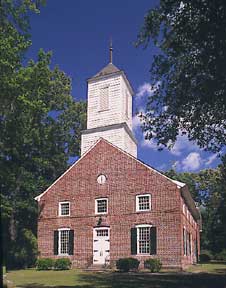 |
|
|
Jerusalem Church, completed 1770, Ebenezer |
On May 1st, the intrepid traveler set off for Augusta with a(41) Mr. J. McIntosh “who was going to attend at the [Indian] Congress.” The trip was made on a good road which “followed the course of the [Savannah] river” almost surely the “Old Augusta Road.”(42) At a place “aposite [sic] Silver Bluff,” Bartram and his traveling companion crossed the river into South Carolina and continued north to the site of old Fort Moore where they crossed back into Georgia, and, after a three mile ride, arrived in Augusta.(43)
Waiting for the Indian congress to begin, Bartram “chose to imploy my time in searching the country round about this place.” He accepted an invitation to visit Wrightsborough “a new [Quaker] settlement about 30 miles from Augusta.(44) At the time Bartram visited the town, it consisted of “about 20 houses.”
Bartram’s participation in the Indian border settlement in Augusta, to which he returned after a few days in Wrightsborough, resulted in an invitation from Col. Barnet for him to join a surveying expedition “consisting of surveyors, astronomers, artisans, chain-carriers, markers, guides, and hunters, besides a very respectable number of gentlemen, who joined us in order to speculate in the lands.”(45)
The party of some “eighty or ninety men” set off from Augusta in early June, 1773, for the Great Buffalo Lick on the headwaters of the Little River (incorrectly identified as the Ogeechee in Travels) by way of Wrightsborough from which Bartram had just returned.
From Buffalo Lick, Col. Barnet’s party followed an old Cherokee trail in a northwesterly direction to “Cherokee Corner” on the boundary between Clark and Oglethorpe counties, about nine miles southeast of Athens.(46) Although Bartram’s geographical descriptions become vague at this point, it is believed that he continued northward with Col. Barnet’s party through eastern Clarke County and western Madison County and then northeastward through northern Madison County, southeastern Franklin County and central Hart County. From about the site of present-day Bowersville (Hart County), the group went east to the Savannah River at the mouth of the Tugaloo. From here, the southerly route to Augusta was “generally through the low lands on the banks of the Savannah.”(47) By the middle of July, 1773, having retraced his earlier route from Augusta, Bartram was again in Savannah.
Excursions in the Low Countries, 1773–1774
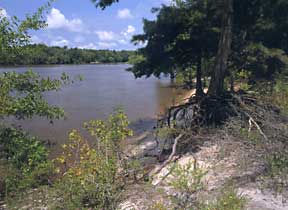 |
|
|
Site of Fort Barrington on the Altamaha River |
The naturalist’s wanderings in Georgia during the summer, fall and winter of 1773 are not recorded in his Travels. The period between July 1773, and March of the following year were spent “in botanical excursions to the low countries between Carolina and East Florida,”(48) but beyond that, we know practically nothing.
Trip to Florida, 1774
Leaving Savannah in March 1774, Bartram proceeded south to the Altamaha presumably by the route taken the year before. There, he “diverted my time agreeably in short excursions”(49) until the arrival of a boat at Darien. Bound for the St. Johns River in East Florida, Bartram “descended the Altamaha, calling by the way of Broughton Island.” He spent the night at Frederica and from there he explored the south end of the island. “Frederica,” Bartram reminds his readers, “was the first town built by the English in Georgia, and was founded by General Oglethorpe, who began and established the colony.”(50) It was from this town that Bartram departed for Florida. His trip was not quite as direct as he had expected, however, for receiving news of an Indian raid at St. Johns, the captain decided to return to Frederica. Bartram “was determined to proceed for the island up St. Johns, where my chest was lodged, there being some valuable books and papers in it which I could not do without.”(5l) So determined, he requested to be put ashore on Little St. Simons (actually Cumberland) Island.
 |
|
|
Fort Frederica, St. Simons Island |
Bartram continued his journey south (to Amelia Island) and thence into Florida where he would remain for at least six months.
Return from Florida, 1774
Leaving St. Johns in the fall of 1774, Bartram took “a neat little schooner”52 to Frederica and then a cargo ship to Sunbury where he dispatched his plant collections and letters to Dr. Fothergill aboard a vessel bound for Liverpool. These matters of business attended to, Bartram “set sail again for Charleston, South Carolina,” where he spent the winter making “short excursions” some of which undoubtedly took him into Georgia.(53)
Exploration of the Cherokee Nation, 1775
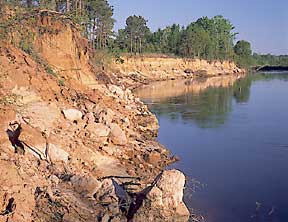 |
|
|
Silver Bluff |
Bartram’s trip into the Cherokee Nation, begun from Charleston in the spring of 1775 (not 1776 as he incorrectly suggests in his Travels) brought him into Georgia from Jasper County, South Carolina, at the “Three Sisters Ferry” on the Savannah River, three miles east of Clyo, Effingham County, Georgia. After an evening’s rest, he set off toward the north on “the high road leading from Savannah to Augusta”(54) crossing into South Carolina briefly, as he had before, at Silver Bluff, and then back to Augusta, Bartram must have been well acquainted with the road by this time, for he had followed it with his father in 1765 and had twice before used it on his own travels.
His travels from Augusta, beginning in May, 1775, took him north to Fort James on the “Washington” or “Petersburg Road,” paralleling the Savannah River, but about three or four miles away from its banks. On this he passed through Columbia and Lincoln Counties in areas now covered, at least in part, by the Clark Hill Reservoir. Today nothing remains of the “square stockade, with saliant bastions” of Fort James, but some of the Indian mounds described and visited by Bartram can still be seen.(55)
His curiosity satisfied by explorations “which were extended to a considerable distance in the environs of Dartmouth,” Bartram continued his northerly route toward Keowee passing out of Georgia (into South Carolina) “six or eight miles up the river about the fort” on May 10th.(56)
After passing into the extreme northeastern corner of Georgia (in present day Chattahoochee National Forest in Rabun County) from South Carolina, he turned north and entered North Carolina.
Exploring the Broad River, 1775
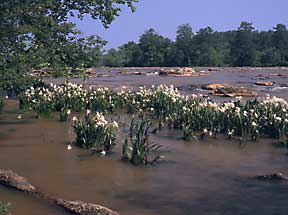 |
|
|
Shoals spider lilies at Anthony Shoals on the Broad River |
Bartram made a brief incursion into Georgia in June, 1775, before heading south with “a company of adventurers for West Florida” while they were making preparations for the “long and hazardous…journey,” at Fort Charlotte, South Carolina, Bartram made “little botanical excursions toward the head of the Broad River, in order to collect some curiosities which I had observed.”(57) No doubt Bartram here refers to his surveying trip of two years before, which took him near the Broad River.
En Route to Mobile, 1775
On his long trip to the Gulf Coast, Bartram’s party entered Georgia by crossing the Savannah at a site now inundated by the Clark Hill Reservoir (at a site about five miles above the Little River). From there they traveled along “the great trading path from Augusta to the Creek nation”(58) in a southwesterly direction through present-day Lincoln, McDuffie and Warren counties. Here, at a place called Flat Rock, they rendezvoused with more traders who had traveled west from Augusta.
The old Indian trading path between Augusta and Macon, which the group most likely followed, ran along the Fall-Line Sand Hills where it encountered the minimum number of streams and swamps. (For the same reasons, it was eventually taken over by the Georgia Railroad, whose tracks cover much of Bartram’s route there today.)(59)
In the vicinity of Sparta, the path turned more to the south, away from the line of the present railroad. It crossed two headwaters of Big Buffalo Creek at a point about three and a half miles northeast of Shelba, Hancock County.(60) Passing through Shelba, it continued southwest to Rock Landing on the Oconee River, just south of Milledgeville. From the Oconee River at Rock Landing to the Ocmulgee River at Macon, the old “Garrison Road” or “Hawkins Trail” takes a fairly direct course roughly comparable to today’s State Highway 49 through Baldwin, Jones and Bibb counties, past the remarkable Ocmulgee mounds (now protected in Ocmulgee National Monument), then continues in a southwesterly direction to Knoxville and Roberta.
Bartram evidently crossed the Flint River near the old Indian Agency presided over by Col. Benjamin Hawkins (1754–1816); on July 5, 1775. From there to the Chattahoochee he traveled through Taylor County, north of Butler, northern Marion County and, keeping south of the Upatoi Creek, Chattahoochee County,(6l) he crossed the Chattahoochee River “with the cheerful and liberal assistance of the Indians” near present Chambers Landing, and continued on his way toward Mobile.
 |
|
The Falls of Coweta on the Chattahoochee River at Columbus, Georgia |
Return from Mobile, 1776
In January of the following year, Bartram retraced his route of the previous June and July along the main trading path from the Chattahoochee to Warren County, Georgia. From near the Ogeechee to Augusta the route was probably through present-day Warrenton, Warren County, through southern McDuffie and western Richmond Counties and then, duplicating his travels with Col. Barnet’s surveying party, through northern Richmond County across Spirit, Butler and Rocky Creeks. Bartram evidently arrived in Augusta in late January, 1776, and proceeded south to Savannah on the same road he had taken many times before. This time, he stopped “to rest and refresh ourselves at the Great Springs, near the road on our left hand about midway between Augusta and Savanna.”(62) The site is that of Blue Springs or Beaverdam Creek, five miles southeast of Hilltonia, Screven County, Georgia.
In the spring and summer of 1776, Bartram “employed myself…in revisiting the several districts of Georgia and the East borders of Florida,”(63) but provides few other clues as to his specific whereabouts. We can speculate that he traveled south following the same route as that taken in 1773 and, based on his description of the Franklinia in this section of his Travels, can be safe in assuming that he was in the Fort Barrington area.
Return to Philadelphia
At the end of October, 1776, Bartram left the lower Altamaha River in Georgia for the last time. Taking the familiar road north toward Augusta, Bartram crossed the Savannah a few miles south of Ebenezer at Zubley’s Ferry and proceeded toward Charleston. His eventual destination was Philadelphia.(64)
Footnotes
N.B. Page numbers for all Bartram quotations will be given in the following way: The first page number cited will be the page on which the passage appears in the first (Philadelphia 1791) edition of the book; the second page number will be the page on which the passage appears in Francis Harper’s Naturalist’s Edition. For convenience in checking the original source, Harper’s edition provides both systems of pagination. When third or fourth numbers appear, they refer to Harper’s commentary, also in the Naturalist’s Edition.
38. Bartram’s Travels, p. 4, Harper, p. 3.
39. For details on the route of this trip, See Harper, Naturalist’s Edition, op. cit., p. 337.
40. Ibid., p. 17, Harper, p. 13.
41. Harper, “Travels in Georgia,” op. cit., p. 135.
42. Ibid.
43. Ibid., p. 137.
44. Ibid.
45. Bartram’s Travels, p. 35, Harper, p. 23.
46. Ibid., pp. 43-44, Harper, pp. 344-345.
47. Ibid., Harper, p. 345.
48. Ibid., p. 48, Harper, pp. 345-346.
49. Ibid., p. 57, Harper, p. 37.
50. Ibid., p. 62, Harper, p. 40.
51. Ibid., p. 64, Harper, p. 42.
52. Ibid., p. 306, Harper, p. 193.
53. Ibid., p. 307, Harper, p. 194.
54. Ibid., p. 314, Harper, p. 198.
55. Ibid., p. 324, Harper, pp. 205 and 383.
56. Ibid., p. 326, Harper, p. 207.
57. Ibid., p. 375, Harper, p. 237.
58. Ibid., p. 376, Harper, p. 237.
59. Harper, Naturalist’s Edition, op. cit., p. 395.
60. Ibid., p. 396.
61. Bartram’s Travels, pp. 375-389, Harper, pp. 394-399.
62. Ibid., p. 461, Harper, p. 291.
63. Ibid., p. 467, Harper, p. 295.
64. Ibid., p. 469, Harper, p. 297 and pp. 417-418.

